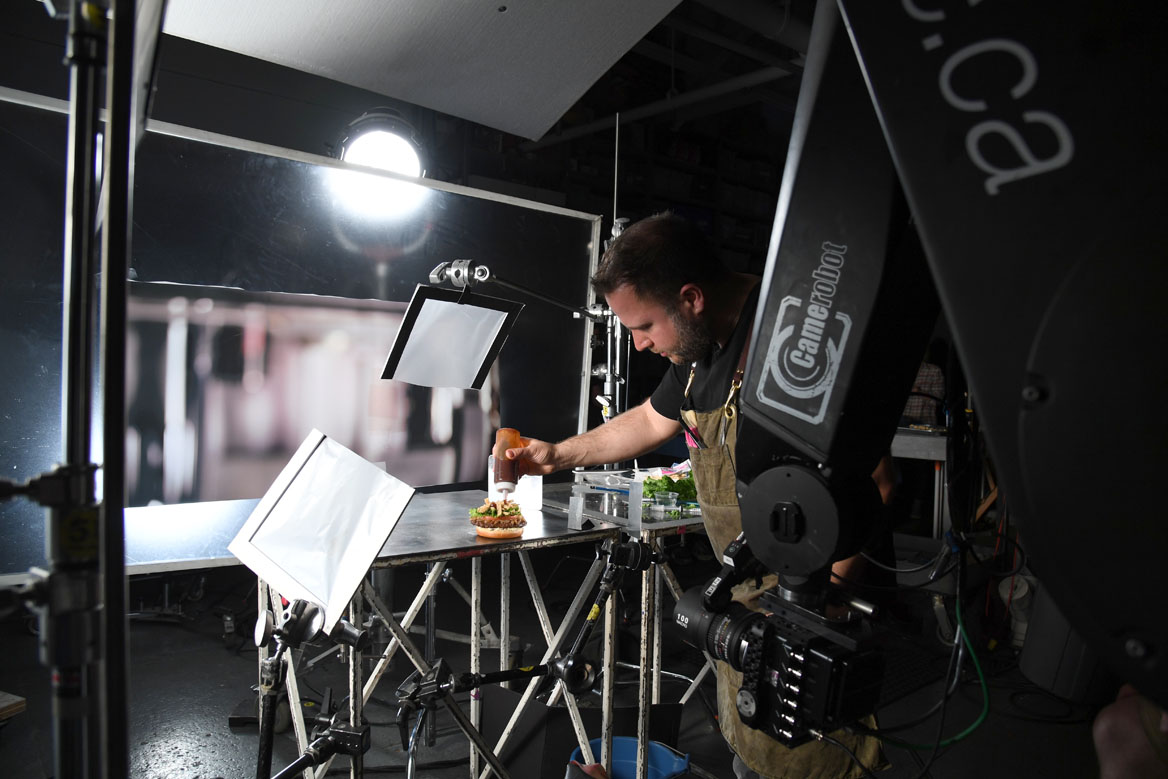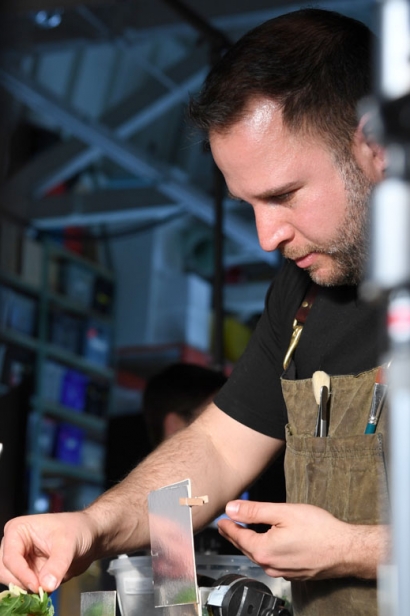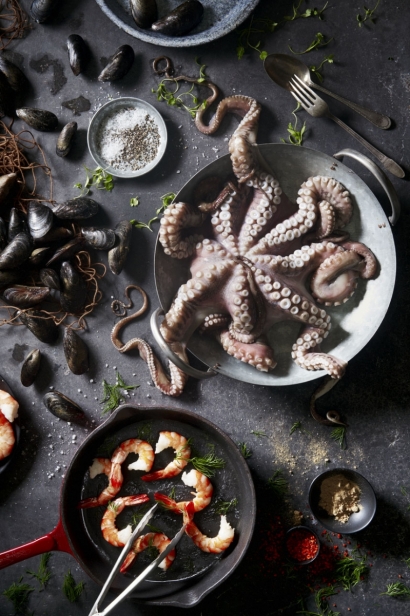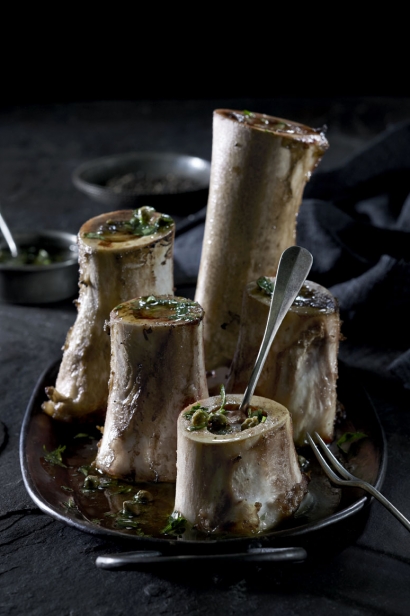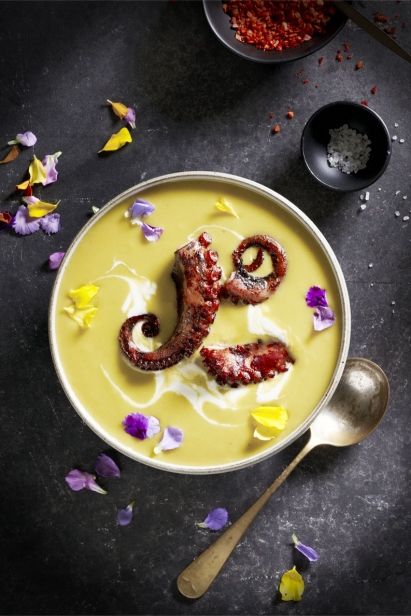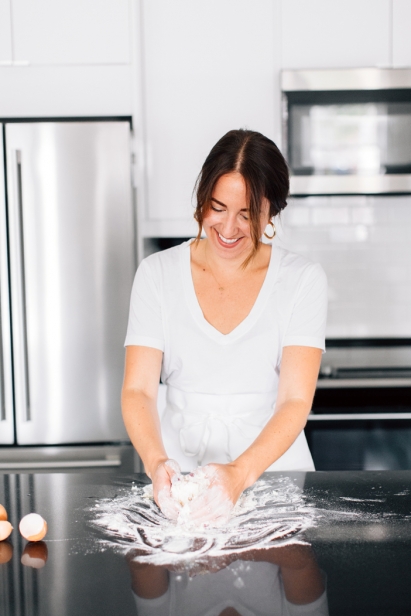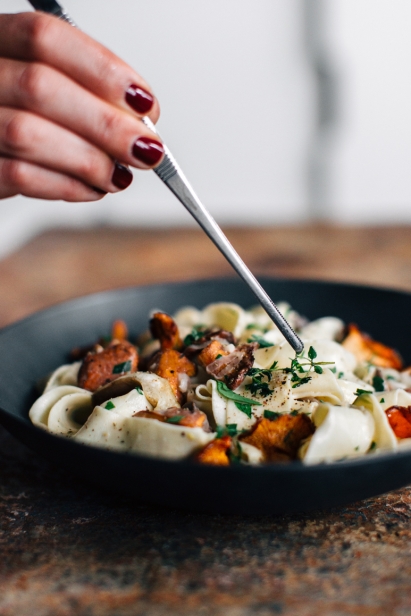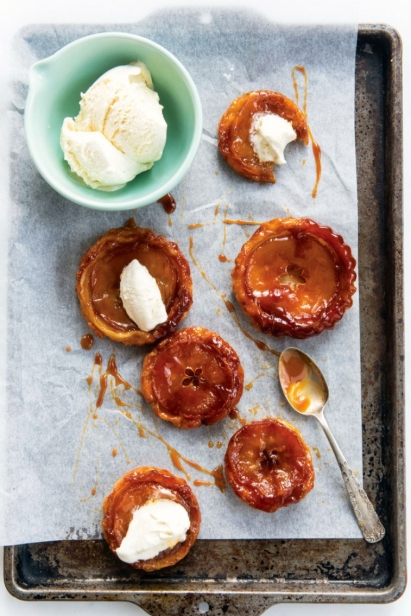Culinary Careers — Stylin'
Their work is ubiquitous. It’s in advertisements, cookbooks, restaurant menus, even on packages of prepared, frozen meals. Food stylists are the folks who plan, prepare and sculpt those irresistible dishes that photographers then capture and we salivate over. Patrick Langston speaks to two Canadian stylists about what makes them get up in the morning for work.
Noah Witenoff
When Noah Witenoff goes to work, he carries blow torches. That’s not something you’d automatically associate with food, but the torches are essential tools of the trade, according to Witenoff. “I use them to crisp up meat, melt cheese, char vegetables because we often shoot barbecued stuff in the winter.”
They’re also a part of an expansive collection of tools, including tweezers (for making small adjustments to food layouts), steamers, spatulas, bowls and much more that Witenoff carts along to photo shoots.
Those tools are in service of his goal as a food stylist: “To make whatever food I’m shooting, whether it’s a frozen food package or a restaurant meal, look as fresh and delicious and full of appetite appeal as possible.”
Toronto-based Witenoff has been doing that since 2005. That’s when he made the jump from a restaurant career into food styling, a job he says he’d never heard of until a cooking school teacher mentioned that she did it and he became intrigued.
Witenoff started off as an assistant stylist and eventually began building his own client base. Acquiring that initial client portfolio and network of photographers was a hard slog, he admits. “I made little gift bags with truffles and business cards and dropped them off to every photographer.”
He relied on his line of credit to get him through that initial phase, but Witenoff is now a respected presence in the profession with an established network of contacts. Working on national and international marketing campaigns, he styles for television commercials, print ads, food packaging and cookbooks by the likes of chefs Corbin Tomaszeski, Brad Long and Michael Smith as well as the Food Network’s Bitchin’ Kitchen and Eat Street cookbooks.
His training and background as a sous chef and pastry chef play directly into his current career.“
A big part of my job is understanding what food does, that it can dry up or change consistency quickly. I have to stop that from happening because the food sits around for a long time while the photographer gets ready and the client or agency make their changes. We use oils, different heat sources to keep it looking fresh. Putting food under wet paper towels keeps it moist.”
Like other stylists, he stresses that he uses real food for his photo shoots. Spraying food with lacquer to make it glisten or covering pancakes with Scotch Guard so syrup slides nicely over them — tricks some stylists are said to use — would never occur to Witenoff.
Still, there must be times he wishes he had a shortcut. His days as a food stylist are long: A nine-hour photo shoot might yield five or six useable images while a 30-second television commercial can easily take more than 14 hours to get just right.
A food stylist needs patience, he says. “You place everything delicately and then someone says, ‘Oh, we don’t like this.’ So you change it all and then they say, ‘You know, we really liked it before.’”
Creativity and insight are also high on the must-have list. For instance, if styling a plate of tacos for a restaurant advertisement, he’d make sure each element is arranged just so, exactly as a good chef would do. If the tacos dish is supposed to have been whomped together at home, it will look a bit looser.
Witenoff enjoys sharing insider tips and does so weekly on Instagram. Among his tips: When you’re arranging a plate, say, with raspberries, use an odd number of them. He doesn’t know why, but “Visually, things look better when they’re odd.”
He can’t help but slip in another tip: Wilted lettuce will spring back to attention if soaked in ice water for a couple of hours. Who knew?
Thirteen years in, Witenoff still loves his job. “It’s always different, food is always changing. I like that I still get nervous before work because that keeps things interesting.”
He says food styling is hard to get into, “but it’s the best decision I ever made.”
Noah Witenoff
416.992.8362 | noah@nustyling.com
nustyling.com | @noahfoodstylist
Dara Sutin
Like a movie, a well-styled dish tells a compelling story according to Dara Sutin, a food stylist based in Toronto and London, U.K.
“You can create a theme and an atmosphere. It’s what draws people in. I work on a lot of cookbooks, and I love when there’s pictures of food and of people or landscapes that complement it; that’s what really tells a story.”
Sutin — whose culinary expertise ranges from food styling to menu creation, recipe development and ghost writing cookbooks — has been telling intriguing visual stories such as this ever since she broke into styling five years ago.
She began her career in food marketing, but had always relished the hands-on side of cuisine (she operated a small bakery in her hometown of Toronto when she was 15) and had long dreamt of studying at Le Cordon Bleu. One day she decided she needed a change, applied to the famous school and was admitted. Despite some minimal trepidation about leaving her safe corporate job (“I wasn’t happy in it”), Sutin was soon studying at Le Cordon Bleu in London, England.
Grand Diplome in Cuisine and Patisserie in hand, she landed a job as a pastry chef at London’s Ottolenghi. But that still wasn’t the perfect fit. “I realized I was quite good at making things look beautiful,” she says, so she began segueing into food styling.
Her initial role as an unpaid assistant eventually led to her current standing as a sought-after pro whose work appears everywhere from cookbooks to print advertisements to billboards and whose diverse client list includes Condé Nast, McDonalds Canada, Loblaws and BBC Good Food.
While building her styling expertise in London, Sutin also established herself as a recipe developer, restaurant consultant and writer. She worked with the likes of Jamie Oliver and Gwyneth Paltrow, whose 2016 cookbook It’s All Easy includes Sutin’s food stylings. Sutin, who says Paltrow is “great” to work with, once cooked spaghetti Bengalese with a dessert of Eton mess for the actor and her then-husband, Chris Martin, because the two were busy moving to a new home. “It was very surreal. I had to pinch myself,” Sutin says.
London was formative for her. “For the first time, I met people who were as passionate about food as I am,” she says. But she spotted a need in the Canadian market for someone with her expertise and returned to her native Toronto in 2017.
Whether Toronto or elsewhere, she says a stylist is in for long, busy days. Advance preparation is critical, especially because a stylist cooks his or her own dishes for the shoot. And a stylist must be adept at collaborating with and assisting others, from clients to props people to photographers. “Working in a kitchen prepared me for long days,” she says.
The rewards, however, are enormous.
“I love that I am cooking and creating,” says Sutin, who uses only real food in her stylings. “I prepare all the recipes from scratch, and when you do that you can really make it your own.”
Making it her own includes the presentation.
“You want things to look real, to look gooey and eaten. For me that’s the most appetizing: When I look at a piece of pie and the ice cream is dripping and it’s juicy and there’s crumbs — that’s what draws a lot of people in. You’re feasting with your eyes.”
She wants everyone to enjoy cooking as much as she does, to understand that they can cook at home and make what they prepare look good. She says her job is to “un-complicate things,” to help ease the fear around cooking.
To make those home cooked meals look even more enticing, Sutin suggests adding garnishes. A couple of sprigs of thyme and some lemon slices, for example, can transform even a dish as simple as salmon.
But what really transforms a dish is less tangible, according to Sutin. “The love you put into your food makes it look better.”
Dara Sutin
647.986.2893 | darasutin@gmail.com
darasutinfood.com | @darasutin


